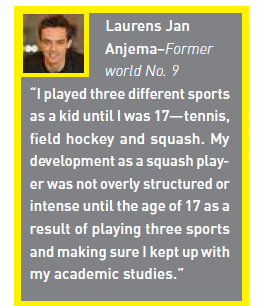By Damon Leedale-Brown, sports scientist & conditioning specialist
The increasing move towards year-round competition schedules and early specialization in youth sports contradicts the majority of research that warns of the risks associated with such an approach for most young athletes (burnout, overuse injury, plateaus in athletic development, losing the love of the game, etc.). Combine this with examples of leading athletes across a range of sports who not only engaged in multiple sports and activities as youngsters, but also had considerably more in the way of unstructured and free play time in sports—both of which they considered key parts of their overall athletic development and sporting success—and it becomes clear that a singular focus on one activity is not required for achieving athletic success.
Over the past two years squash has joined the ranks of those sports in the U.S. that offer a year-round cycle of competition for young players. Traditionally the main competitive season for advanced junior players ended with the Junior Nationals in March, following which there would be a four-month break from tournaments before the start of the next competition season in September. In 2015, following Gold Nationals in March, there will have been a total of nine Gold level junior events on the calendar over the spring and summer months before the start of September. Add to this the European summer junior events that attract many U.S. Junior players, along with new events such as the regional team championships, and summer could soon become one of the busiest competitive periods for a junior squash player.
Of course participation in these events is voluntary, but if you speak with many parents there seems to be a sense of pressure to enter their kids into certain events so as not to miss out on ranking points or allow lower ranked players to benefit from a weaker event.
Within the current youth sports environment in the U.S., it is easy to lose track of the number one reason that kids are involved in any sport—they love to do it! At times sport can be extremely challenging, with plenty of lows and tough losses, but above all it will be the love of the game that will help any child move past these hurdles and inspire them to keep improving as a player, athlete, and teammate.
To support the points above, here are a few reflections from leading college and pro players on the path they took through their junior careers:


So as squash parents and coaches how do we make sure the love of the game is not lost along the way in our young athletes?
1) Make sure there are opportunities to take time away from competition. It is not healthy for any athlete to play competitions in one sport year round – you can easily get to the point where the body and mind feel fatigued and stale from playing too many events in a row, and sometimes a break from competition (from a few weeks to a few months) is all that is needed to help renew the passion and spark for the sport.
2) Create time and opportunities to allow them to engage in other sports that, in most instances, will help develop athletic skills and abilities that complement and enhance a young player’s squash game.
3) Remember that periods of rest or active recovery away from competition are important for any young athlete’s mental and physical well-being—both short and long term—try and see the big picture, not simply the here and now.
4) For well-motivated and committed young players, time away from competition allows them to step back and assess their game, and spend time working on areas they want to develop and improve upon before they head back into the competitive season.
5) Make sure young athletes have time just to be kids, have fun with friends, play pickup games, and try out new sports or activities without the constraints of formal competition.





